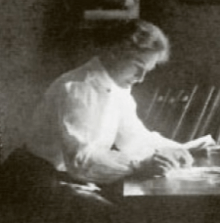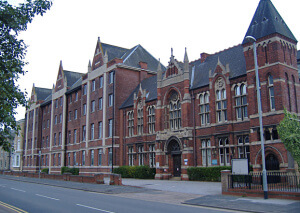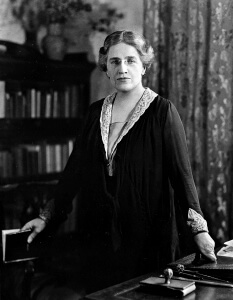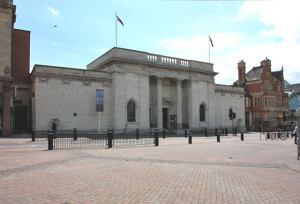Hull was fortunate to have one of the 1st women GPs in the UK. Dr. Mary Murdoch. At the time my grandparents lived in the city and it would be interesting to know if they had heard of her. They lived in East Hull, so it’s unlikely they were patients in her practice on Beverley Road. It was before NHS so they would need to pay.
Dr. Mary Murdoch at work
Her background was different from that of either of my grandmothers. Born in in Elgin, Scotland in 1864, the youngest of 7 children, she was educated by governesses and at schools in Elgin, London and Switzerland. While she was looking after her mother between 1883 and 1885, she became interested in medicine. Using her mother’s inheritance, she studied and graduated from the London School of Medicine in 1893.Dr Mary Murdoch, one of the first women to do so. Her first appointment was as House Surgeon at the Victoria Hospital for Sick Children in Park Street, Hull.
She seems to have been a feisty woman. She and Dr. Martindale went cycling together in Europe visiting Vienna, Berlin and Switzerland. She had a car and loved to drive it at speed.
Victoria Hospital, photo by Paul Harrop 2011
By 1910 she was the first female GP in Hull. She listened to her poorer patients and became involved in several public campaigns to improve living conditions in the city. She founded the first creche in Hull and raised the ire of some local Conservatives because she became a vociferous critic of poor quality housing in Hull. Before women and men without property, were allowed to vote, Dr. Murdoch founded the Hull Women’s Suffrage Society and she and her friend and colleague, Dr Louisa Martindale held committee meetings in the house they shared in Beverley Road. She gave talks at the International Council of Women in Toronto (1909), Stockholm (1911) and Rome (1914).
Dr. Louisa Martindale
The suffragist movement was more popular in Hull than that of the suffragettes and Emmeline Pankhurst campaigned in Hull. I wonder what my grandparents made of it. How much aware. How relevant was it to their daily lives?
Lord Frederick Leighton, who was a critic of the suffrage movement had his painting, Farewell, removed from Ferens Art Gallery in Hull, in case it was damaged by activists. However, by September 1914, it was back on display after a truce between the gallery and the women had been called. In 1914, the painting, Rokeby Venus by Velasquez was damaged by a suffragette so Lord Leighton may have grounds for his fears.
Ferens Art Gallery, Hull
photo: Peter Church, Wikipedia
On the outbreak of war in 1914,Dr. Murdoch helped treat the sick and wounded. Sadly, she died of pneumonia at her home in Hull on 20th March 1916, after going out in the snow to visit an emergency patient.
At her funeral many Hullensians joined the funeral procession to the Lady Chapel of All Saints Church, Hull, where her urn was placed. I wonder if any of my grandparents were among them.
References: https://www.carnegiehull.co.uk/hull-firsts/dr-mary-murdoch.php
Other information and photos obtained from Wikipedia





Recent Comments